Mushrooms that grow in grass make up a large part of the inhabitants of the mushroom kingdom, and among them, there are also culinary delicacies, species that should be kept away from, and those whose use is better not to mention aloud.
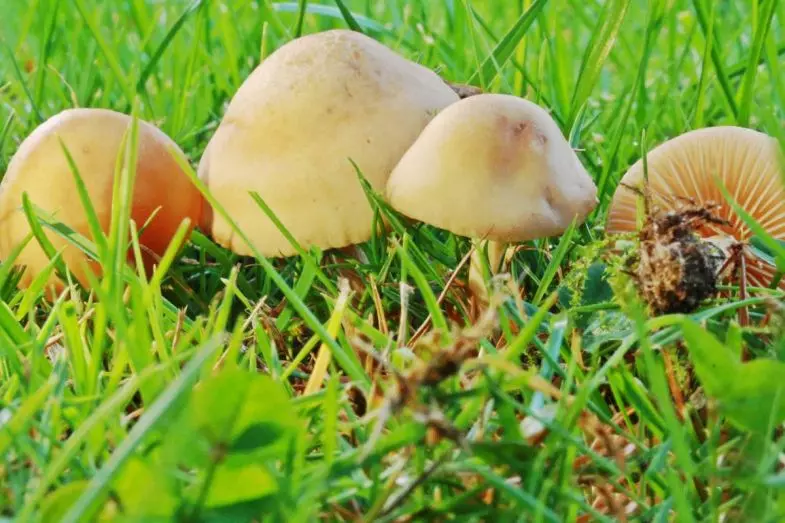
Table of Contents
why do mushrooms grow in grass?
Mushrooms have actively populated the whole world around us, and although it is traditionally believed that quiet hunting is a mandatory trip to the forest, in fact, many types of mushrooms prefer not shady forest thickets, but green grass expanses of fields and meadows, where there is plenty of suns, fresh air, special field, soil composition, and if we are talking about grassy pasture meadows and a lot of nutritious manure, which is very useful for a comfortable habitat for some types of mushrooms.
There are many types of mushrooms that grow in grass on fields, meadows, upland pastures, gardens, and yards, and this article covers some of them.
Edible mushrooms that grow in grass
Types of mushrooms that grow in grass will always delight connoisseurs of quiet hunting and lovers of a delicious mushroom dinner.
Agaricus Campestris mushroom grows in grass
Mushroom from the genus Champignon, the Champignon family, also known as Field mushroom.

Appearance Agaricus Campestris mushroom in grass:
- The cap is up to 15 cm in diameter, initially hemispherical, with a wrapped edge, later convex – prostrate, may have a finely scaly structure. The hat is painted white, turning a little brown with time, the scales in the center may have a brownish tint.
- The hymenophore is lamellar, the plates are thin and frequent, wide and loosely attached, initially white, then turn pink and darken, up to dark brown, with a purple tint. Initially, the plates are covered with a light veil, which breaks over time, and its remnants hang down along the edges of the cap. Spore powder is dark brown.
- Leg up to 10 cm long and up to 2 cm thick, smooth and solid, cylindrical, sometimes slightly narrowed towards the base. The color of the stem is almost the same as that of the stem, at the base it can sometimes be brownish-rusty. There is a wide and thin white film ring on the stem, often disappearing with time. Sometimes it is shifted closer to the middle of the leg.
- The pulp is fleshy and dense, white, turning pink, and then turning red on the cut, with a pleasant mushroom smell and taste.
growing conditions of Agaricus Campestris mushroom in grass:
It grows from the end of May to the end of September in open spaces rich in humus grass on soils – meadows, pastures, gardens, and parks, even sometimes in cities on fertilized lawns. Fruits in groups every year.
culinary use
A magnificent and very tasty mushroom, suitable for any kind of culinary use. These beautiful porcini mushrooms are well known to all lovers of mushroom cuisine.
False and poisonous mushroom
Mushrooms that grow in grass can easily be confused with Pale Toadstool, due to the wide ring and light color, especially in young specimens of the fungus, in which the plates have not yet begun to turn pink. You can distinguish them by the presence of an egg – a tuber at the base of the toadstool, but if there is even the slightest doubt that it is champignon, it is better to leave the mushroom in place – a mistake can cost you your life. Pale Toadstool is rarely found in mushrooms that grow in grass, but can grow on the edge of the forest, as well as grass on Meadow Mushroom.
Marasmius Oreades
The cap is up to 5-8 cm in diameter, initially conical, then almost prostrate with a blunt tubercle in the center. The oldest specimens may dry up to a cupped shape. The hat is painted in yellowish-brown shades, very brightening when dried, up to dirty white.
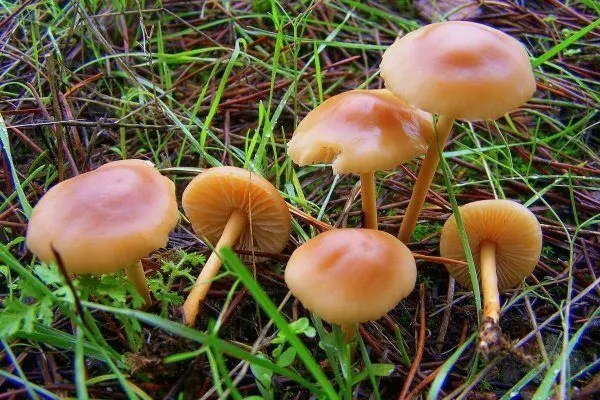
The hymenophore is lamellar, the plates are rare and rather wide, initially adherent, then free, painted in whitish-cream shades. Spore powder white.
The leg is up to 6 high and up to 0.5 cm thick, fibrous and thin, slightly lighter in color than the cap, becoming very stiff with age.
The pulp is thin, pale yellow in color, with a pleasant aftertaste and a characteristic smell, similar to the smell of cloves or bitter almonds.
growing conditions
It grows from June to the end of October in grass on meadows and pastures, in glades and forest edges, along roadsides. As a rule, fruits in large groups, often forming “witch circles”.
culinary use
A magnificent and very tasty mushroom, suitable for any kind of culinary use.
Lepista Saeva (Lepista personata) mostly grow in grassy areas
A fungus from the genus Lepista, family Tricholomataceae, also known as Blue-legged, Lepista personata and Blue Root.
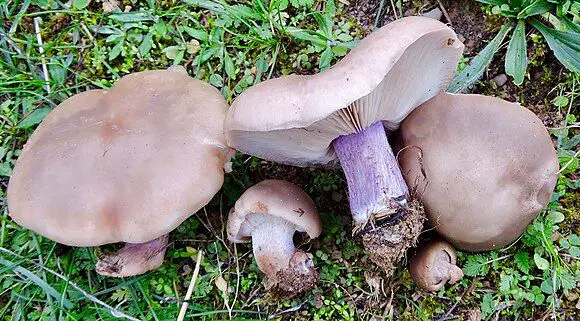
The cap is up to 15 cm in diameter, although specimens up to 25 cm in diameter have also been seen, flat-convex or cushion-shaped, yellowish-violet in color.
The hymenophore is lamellar, the plates are wide, free and frequent, painted in yellowish-cream shades. Spore powder is pale pink.
The leg is up to 10 long and up to 3 cm thick, smooth, with a slight thickening at the base, bluish – grayish – purple hues. As the stem matures, the surface of the stalk changes from fibrous and covered with the remains of a spathe to smooth and clean.
The pulp is thick and dense, loosening with age, purple-gray shades, with a pleasant sweetish aftertaste and fruity aroma.
Growing conditions
It grows from April to November, can actively bear fruit even at low temperatures. It lives in grass on meadows and pastures, on well-fertilized soils, near old compost heaps, next to residential buildings. It can also be found in the forest next to deciduous trees.
Culinary use
An excellent edible mushroom suitable for any kind of culinary use.
Umbrella White (Macrolepiota Excoriata)
Mushroom from the genus Macrolepiota, the Agaricaceae family, also known as Meadow Umbrella.
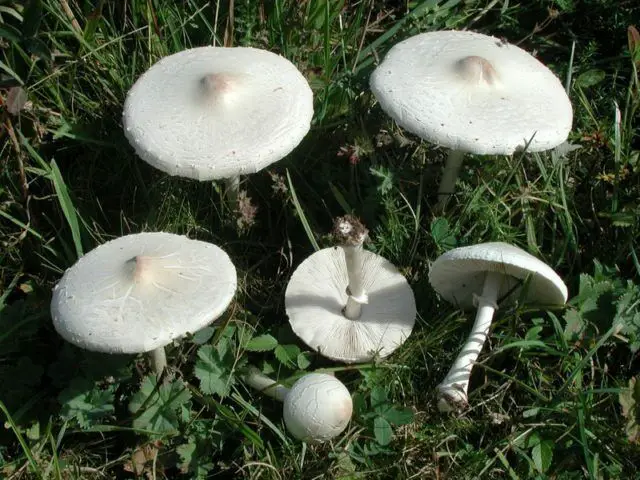
The cap is up to 12 cm in diameter, initially elongated – ovoid, then gradually opens up to flat prostrate with a large tubercle in the center. The color of the cap is whitish-cream with a brown center, the surface is smooth in the center, covered with thin scales along the periphery. Small flaky fibers are visible along the edges of the cap.
The hymenophore is lamellar, the plates are even and frequent, with small plates and a cartilaginous ring – the collarium. The plates are painted in white shades, acquiring brownish-cream shades with age. Spore powder is white.
Leg up to 12 cm high and up to 1.2 cm thick, hollow and cylindrical, with a slight thickening at the base, sometimes slightly curved. The ring on the leg is white, wide and smooth. Above the ring, the stem is white, below it is yellowish-brown, slightly browning when pressed.
The pulp is white, with a pleasant taste and smell, in the leg – longitudinally – fibrous.
growing conditions
It grows from May to November in grass on meadows and in the steppe zone, where it reaches its maximum size. Likes well fertilized humus soils. May also be found in forests.
Culinary use
A good edible mushroom suitable for a variety of culinary uses.
Dangerous mushrooms that grow in grass
In addition to the dangerous twins of edible mushrooms that grow in grass already mentioned, in the expanses of meadows and pastures grass you can find many other inedible or poisonous species, as well as mushrooms that are basically edible, but have some specific features.
yellow-staining mushroom (Agaricus xanthodermus) commom mushroom that grow in grass
Mushroom from the genus Champignon, family Agaricaceae, also known as the yellow-staining mushroom.
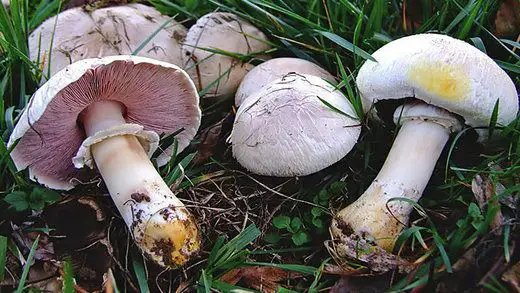
The Cap is up to 15 cm in diameter, initially rounded, and then bell-shaped, painted in yellowish tones, with a brown middle.
If you press on the cap with your finger, then this place will turn yellow sharply.
The hymenophore is lamellar, the plates are thin, initially pinkish in color, then become grayish-brown. Spore powder is dark brown.
The leg is white, up to 15 long and up to 2 cm in diameter, hollow, with a tuberous thickening at the base. There is a light ring on the leg.
The pulp is brownish in color, yellowish in the lower part of the stem, and yellowish-orange inside the tuberous swelling. The pulp has a pronounced unpleasant phenolic odor, which is especially enhanced by heat treatment. When cooked, the flesh also turns yellow even more.
growing conditions
Yellow-skinned Mushrooms grow from July to October, both in mixed forests and in grass on meadows, in parks and gardens.
Golden Bootleg mushroom (Phaeolepiota aurea)
Mushroom from the genus Theolepiota, the Champignon family, also known as golden cap and golden bootleg.
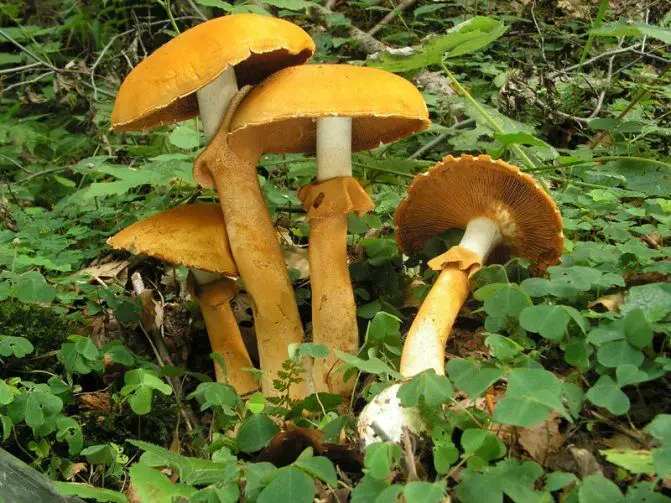
The Cap is up to 25 cm in diameter, first hemispherical, then convex – prostrate, with a small tubercle in the middle. The hat is painted in ocher-yellow shades, sometimes with an admixture of orange. There is a pronounced granularity on the cap, which is especially noticeable in young mushrooms.
The hymenophore is lamellar, the plates are thin and frequent, adherent, initially painted in pale yellowish-buffy shades, and with age they become rusty-brown. Spore powder is rusty-brown.
In young specimens, the plates are covered with a membranous veil, which is torn over time, often leaving tatters on the edges of the cap.
Leg up to 20 cm high and up to 5 cm wide, straight, may have a thickening in the middle and a thickening at the base. The leg, in young mushrooms, is colored approximately the same as the cap, and also has a pronounced granularity, then darkens down to a rusty-brown hue. After the cover falls off the plates, a film ring remains on the stem, the same color as the stem.
The Pulp is fleshy and thick, without a pronounced taste and smell, whitish, yellowish or reddish hues.
growing conditions
It grows from July to the end of October in grass on fields, meadows and pastures, along roads or in forest clearings in deciduous forests, on richly fertilized soils.
The mushroom is listed in the Red Books of some regions.
Golden Waxcap mushroom (Hygrocybe chlorophana)
A fungus from the genus Hygrocybe, Hygrophoraceae family, also known as waxcap.
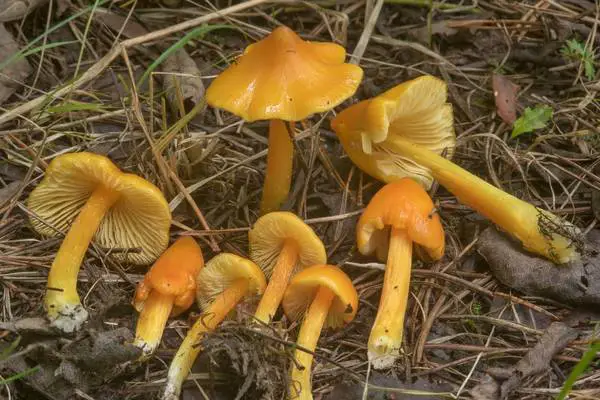
The cap is up to 7 cm in diameter, first hemispherical, then convex, and finally almost flat, sometimes with a small depression or tubercle in the center. The hat is painted in lemon-yellow tones, slightly sticky and has a scar along the edge.
The hymenophore is lamellar, the plates adhering to the stem are initially light, then turn yellow, up to a yellow-orange hue. Spore powder is white.
The Leg is up to 8 long and up to 1.2 cm thick, slightly lighter than the brittle cap, becoming hollow with age.
The pulp is fragile and yellowish, without a pronounced taste and smell.
growing conditions
Grows from May to October in meadows grass and mixed forests, singly or in small groups.
liberty cap (Psilocybe Semilanceata)
A fungus from the genus Psilocybe, family Hymenogaster, in the USA it is Known as Liberty Cap and in the UK the magic mushroom.
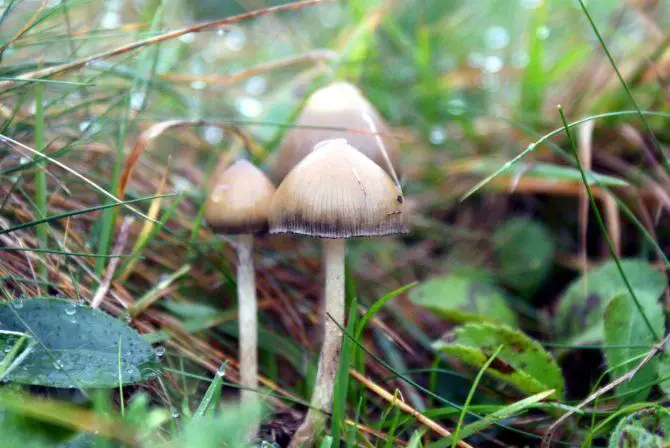
The cap is up to 25 mm in size, conical or semicircular in shape, with a small tubercle at the end and a mucous skin. The color of the cap varies from beige to olive brown, depending on the degree of humidity.
The hymenophore is lamellar, the plates are rare, initially buffy, and then grayish-black, with a white edge. Spore powder is dark brown.
Leg up to 10 cm high and up to 3 mm in diameter, very thin and high, strong, elastic and hollow, often slightly curved. The leg is painted in whitish-yellowish shades, often with a bluish base. Sometimes scales are visible on it.
The pulp is thin, yellow-cream in color, with a mild taste and a slight smell of mold. On the break and when dried, the flesh turns blue.
growing conditions
It grows from late August to November, in meadows, fields, and pastures grass, and loves high humidity and not very high temperatures.
Conclusion
Growing under the friendly sun, mushrooms that grow in grass, no less than forest ones, are able to please us with a variety of shapes, colors, properties, and tastes. And the difference between mushroom hunting in grass on meadows, yards, gardens, pastures, and forest hunting will always add new interesting experience and knowledge to you.